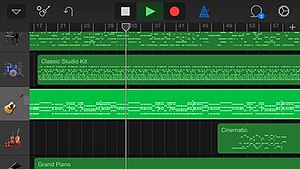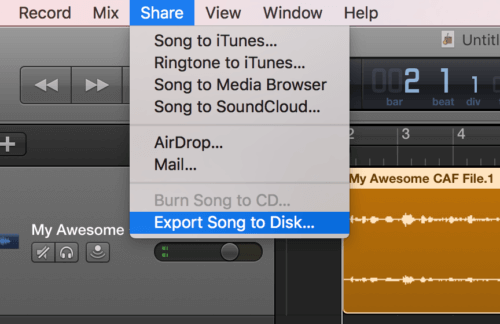Oct 04, 2018 Here’s how to export GarageBand stems. Photo: Cult of Mac. The usual stem-export workaround is to mute all the tracks but one, then export your GarageBand project as a WAV track.
Want to turn that GarageBand masterpiece into an MP3 or ringtone? Your MacBook gives you that option. You can create an MP3 or AAC file (or an M4R file for a Mac, an iPhone, an iPod touch, or an iPad ringtone) from your song or podcast project in just a few simple steps:
Open the song that you want to share.
Choose Share→Send Song to iTunes.
GarageBand displays the settings.
To create a ringtone and send it to iTunes, choose Share→Send Ringtone to iTunes.
Click in each of the four text boxes to type the playlist, artist name, composer name, and album name, respectively, for the tracks you create.
You can leave the defaults as they are, if you prefer. Each track that you export is named after the song’s name in GarageBand.
Click the Compress Using pop-up menu and choose the encoder GarageBand should use to compress your song file.
The default is AAC, but you can also choose MP3 encoding for wider device compatibility.
Click the Audio Settings pop-up menu and select the proper audio quality for the finished file.
The higher the quality, the larger the file. GarageBand displays the approximate file size and finished file information in the description box.
Click Share.
After a second or two of hard work, your MacBook opens the iTunes window and highlights the new (or existing) playlist that contains your new song.
By Malcolm Owen
Monday, April 09, 2018, 12:41 pm PT (03:41 pm ET)
The music and sound effects that can be bought from Apple's extensive tone collection is a great resource for making an iPhone stand out or make it fit with your personality. Even so, there is always the option of making your own tones, for free, by using GarageBand to create and export the sound to your device.
While this was previously fairly simple to do, changes in iTunes means that it's not as straightforward to find your custom tones once they have been produced. This guide will go through the entire process, from creating and exporting, to finally adding it to a contact on your mobile device.
Creating a Tone
Open GarageBand on your Mac.
If you already have a composition that you wish to use, click Open an existing project and select and open the project file. You can skip to the Export the Tone section below.
If you are starting from scratch, select New project and Ringtone, followed by altering the tempo and other settings before clicking Choose.
At this point, you will have to create your ringtone, just like producing any other GarageBand track. This can range from full-blown musical productions using GarageBand's included loops, laying down new recordings with instruments, or even recording someone speaking into a microphone.
Once you have created your project, save it by selecting File then Save or Save As... in the menu. Enter a name for the new tone, select where to save it, and hit Save.
Export the Tone
Once you are happy with the tone, select Share in the menu followed by Ringtone to iTunes..., which will bring up iTunes.
If your ringtone is longer than 40 seconds in length, GarageBand will warn that it exceeds this limitation, and needs to be corrected. If you are fine with GarageBand automatically trimming the composition to the correct time, select Adjust, or select Cancel to adjust it manually.
For manual adjustment, click the Cycle button in the project window to enable a yellow bar at the top of the screen. Drag the center of the bar to reposition it in the composition to cover the period you want as a ringtone, and drag the ends to adjust how long the cycle duration lasts.
An attempt to share to iTunes again will use the period selected by the Cycle button.
Earlier versions of iTunes would bring up the Tone menus, but the current 12.7 release does not offer this option. While it isn't visible, the tone will have successfully exported, and is in the iTunes library, but findable via Finder.
Use Finder to bring up the iTunes Media Import folder. The path from the main drive is usually Users > the user's folder > Music > iTunes > iTunes Media > Import
Export Garageband Iphone To Mac Pro
. The file in that folder will be the finished ringtone in the .m4r file format.Importing the Tone
Connect your iOS device to your Mac. While this can be done with a Lightning to USB cable, it is also possible to do this if Sync with this device over Wi-Fi is enabled.
Click the device icon near the top left of the iTunes menu to bring up the iPhone. Under the left panel's 'On My Device' section, select Tones, and drag the created tone file to the tone list. This will import the tone into the device's tone library, and make it ready for use.
Setting the Tone
 At this point, you can see the tone in question in the iPhone's Settings app, under Sounds then
At this point, you can see the tone in question in the iPhone's Settings app, under Sounds then  Ringtone
RingtoneHow To Export Garageband Ios
. Select the new ringtone to make it the default for the device.If you want to set it as a custom tone for a specific contact, allowing users to know who is calling before seeing the phone's display, this can also be done.
Select the contact you wish to apply the tone to within the Contacts app, and select Edit. Scroll down to Ringtone and tap the
 existing tone. Scroll through the ringtone list to find the new entry, and select it.
existing tone. Scroll through the ringtone list to find the new entry, and select it. More Notes
It is advised that readers do not import music tracks they do not have permission or the rights to use for their own ringtones, for copyright-related legal reasons. Also remember that you can send the exported ringtone file to more than one device, and also to others to use on their own iPhones.
It is also possible to create a ringtone using GarageBand for iOS, then set it as the iPhone or iPad's tone. AppleInsider